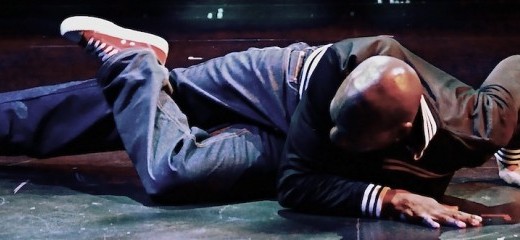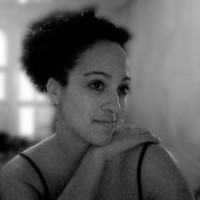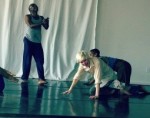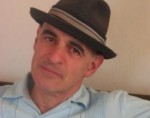
Photo: RaphaelXavier.com
Philadelphia Dance Community On The National Scene
by Julie B. Johnson & Becca Weber
How does a close-knit arts community represent itself to a nationwide audience? This was the question as Philadelphia played host to the National Performance Network’s Annual Meeting.
Presenters, agents, funders, and artists come from all over the country to attend NPN. They gather in a new city each year to network, discuss issues in the field, and present and/or watch performances. This year’s theme was “community engagement.” With its vibrant arts culture supporting a diverse dance scene accessible to all - what better city to receive the honor of hosting than Philadelphia?
The network consists of about 70 arts organizations working in rural, urban, and suburban communities across the United States. Two of Philadelphia’s arts organizations, the Asian Arts Initiative and the Painted Bride, shared hosting duties this year. They welcomed over 300 guests from California, Florida, Illinois, Minnesota, Massachusetts, New York, and more. Attendees enjoyed a full weekend of performance showcases (excerpted works by selected NPN artists and invited local performers), plenary sessions, and arts tours around the city.
Friday
In Friday afternoon’s Live and Onstage Showcase at the Painted Bride, Philadelphia was represented by Dr. Kariamu Welsh’s Kariamu & Company: Traditions and DaDaDance Project, a collaborative venture by Guillermo Ortega Tanus and Eun Jung Choi. Welsh’s Raaaahmona Revisited began with an impassioned solo by dancer Saleana Pettaway. Pettaway’s gaze pierced through the audience as she roared at the top of her lungs “Raaahmona!” Her bright red dress suggested blood-boiling anger and was matched by fiercely percussive foot stomps and slicing arm gestures. This dance was inspired by the 1985 tragic MOVE bombing – a police raid resulting in the burning of dozens of Philadelphia homes and the death of eleven people including five children – and the story of survivor Ramona Africa.
In contrast, Choi and Tanus’ duet, Auroras, was all smiles and giggles, thoughtful touches and unexpected push/pull partnering. From big, bouncing explorations of gravity to the minute details of a pinky finger or inverted foot, Auroras led the audience through a fun and idiosyncratic examination of the relationship between light and lunacy.
Friday night’s Live and Local at The Underground Arts gave conference-goers an opportunity to further appreciate the Philadelphia dance scene with excerpts from works by well-established artists including: Kun Yang Lin/Dancers, Raphael Xavier, Nichole Canuso, Miller Rothlein (MIRO), and Germaine Ingram with musician Bobby Zankel.
Ingram and Zankel’s vibrant excerpt from The Spirits Break to Freedom presented the perspectives of Hercules and Olney Judd, the escaped slaves of George and Martha Washington. Ingram’s heartfelt vocals and commanding tap dancing were seamlessly interwoven into this narrative told through music and dance. She was accompanied by two other tap dancers and a five-piece jazz band. The dance culminated in a solo depicting Hercules’ struggle. As the music died, his footwork quickened, sending shivers that rose from his feet up through his body. The audience was left with the stirring image of his facial expression—afraid and apprehensive—suggesting the tension between Hercules’ desire for freedom and the risk of death he faced in escaping his enslavement.
The bare, dark charcoal-colored walls and floors in the cold yet surprisingly inviting basement of Underground Arts provided a stark backdrop for the night’s multi-modal works. MIRO gave a minimalist and unplugged performance: sound and lighting were delivered by a hand-cranked phonograph and flickering slide projectors powered by two stationary bicycles. In Lin’s Passages, a nearly nude Olive Prince writhed slowly as she gingerly emerged from a red mesh encasement.
Xavier blended spoken-word with athletic hip-hop dancing to educate audiences on the experience of being school-aged in inner-city Philadelphia. At one point, Xavier spat, “Nothin’ could stop me; my body was like origami,” a fitting image as two men in upside-down shoulder freezes slowly folded and extended their legs, creating a series of structured shapes that seemed to defy gravity.
Halfway through Kitchen Sink, Canuso suddenly stopped to talk to the audience. She shared her process, her concerns, and her considerations. We learned that the masking tape pattern covering the floor was a “memory map” of her childhood home. As she described the memories that interrupt the space (a Christmas tree, a guinea pig, a dead body), she revealed the secrets that usually distance us from choreographers.
Saturday
Saturday evening’s program back at the Painted Bride featured notable showings from Philadelphia locals Team Sunshine Performance Corporation, Jennifer Childs/1812 Productions, and Anonymous Bodies || Art Collective.
Team Sunshine Performance Corporation, presented JapanAmerica Wonderwave, a humorous and moving look at the Japanese tsunami’s effects from far-away American soil. Hand-written captions describing daily actions were paired with the vernacular of club-dance gestures (fist-pumps, head bobs) and interspersed with awkward movements (at one point the dancers jump in the air and flop like fish). The piece ended with performer Makoto Hirano blowing on a table full of tiny foam houses floating in the sea of water Benjamin Camp had just poured on them. This somber final image brought home an awareness of the depth of the tsunami’s effect.
Childs entertained an uproarious crowd with an excerpt from her theater treatment Why I’m Scared of Dance. Clad in a leotard, tights, and fluffy tutu, Childs outlined the difficulties of being an adult ballet beginner. Using props, she guided her body into an absurd approximation of balletic posture. She tightened a belt to hold her “bellybutton to spine,” and used ribbons that extended from mid-arm to teeth in order to keep her elbows higher than her wrists. Childs summarized her piece with an opening line: “It looked so easy! […] I thought ‘I could do that!’...and then I took a class.”
Jaamil Olawale Kosoko of Anonymous Bodies || Art Collective entered the stage from the audience and stepped into a pair of white sneakers with manacles shackled to a chain connected to a basketball. Swinging his arms, hands gradually dropping roses, he danced to the sound of an NPR interview regarding the term “post-racial.” Kosoko’s movement was minimal, his bent knees and slight bounce and sway echoing hip hop like a subtle top rock. He then rolled and tumbled around the stage—growing ever more entangled—finally exiting through the audience, chains clanging and dragging behind him.
Reflection
The Annual Meeting provides the opportunity for NPN members to meet face-to-face and engage in discussion about the arts. While here, NPN presented an array of works by artists from across the country as well as a diverse sampling of what Philadelphia’s performing arts community has to offer. Those visiting from afar had much to take away, and impressions and opinions on the scene here were as varied as the works shown. Jesse Keller of The Yard in Massachusetts said she noticed “the influence of hip hop culture here” as well as “the prevalence of Asian culture in the dance work” in this “supportive, smaller community.” Christy Bolingbroke, Theatre Director of ODC in San Francisco, remarked on the prevalence of dance theatre work.
Ivan Sygoda, Director of the New York-based nonprofit organization Pentacle, commented on the liveliness of Philly’s dance scene and considers the city a “dance destination.” He remarked that Philadelphia artists tended to be “bright, aware, committed, and politically astute. More often than not, the dance is about something.” As a visitor who is more familiar with Philadelphia offerings, Sygoda noted aspects of the community which were missing from the works presented to NPN-goers—notably the diversity of cultural forms, such as traditional Indian or Asian forms, and more classical forms, particularly ballet.
We agree. Although the works presented were varied in scope, since our community is so broad any selection of work will be incomplete. Certainly, Philadelphia is home to many modern, contemporary, and experimental forms–but we also honor classical traditions. Many artists do mix-and-match across genre: dance and theatre, Asian or African diaspora influences and modern dance, hip hop and spoken word, jazz music and tap dance. Artists here are a collective of unique yet distinctly “Philly” voices that feature a range of influences and engage in both traditional techniques and experimental, cross-genre performance. NPN attendees or any out-of-towner new to this scene can be sure they will find dance happening throughout Philadelphia—in basement black box theaters, transformed church spaces, large proscenium stages, and even out on the streets. They will find artists uniting dance with other mediums and works wholly grounded in movement. They will find dancers collaborating with other artists and dancers who seem to partner with their surroundings. Whether inspired by a Philadelphia life experience, the Aurora Borealis of Alaska, an event in our nation’s history, or something more abstract, the Philadelphia dance community works to bring it close. Step outside your door on any given day, walk or ride for just a few short minutes in any direction, and you will find it.
National Performance Network Annual Meeting’s
Live and On Stage, the Painted Bride, December 14-15;
Live and Local , Underground Arts, December 14, 2012.
By Julie B. Johnson
January 6, 2013









